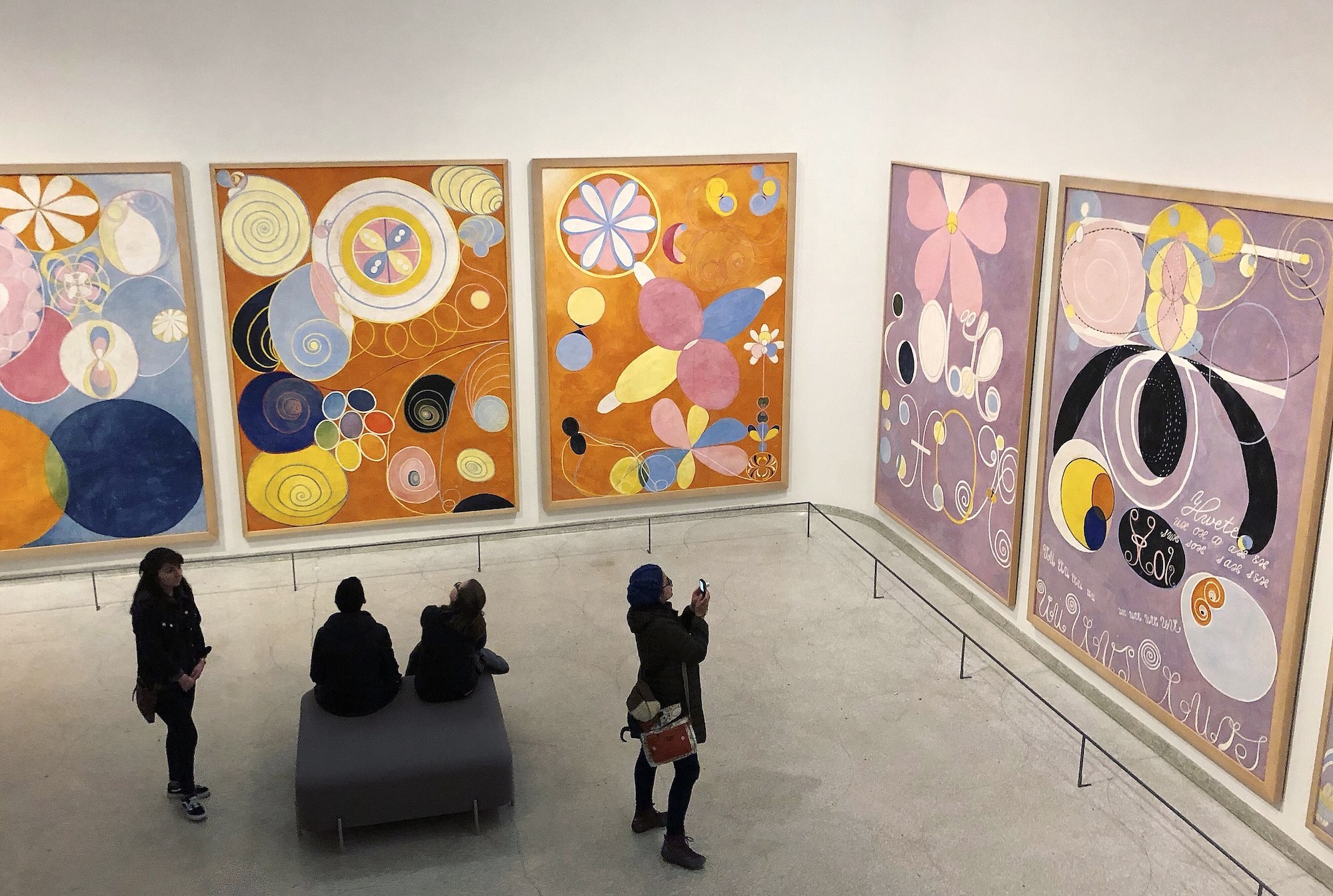Hyperallergic
Sensitive to Art & its Discontents
Over 160 non-fungible tokes (NFTs) of works from Swedish artist Hilma af Klint’s Paintings for the Temple series were released for sale by the digital art company Acute Art and Stolpe Publishing on Pharrell Williams’s GODA (Gallery of Digital Assets) platform this week — despite the strong objections of a relative of the artist.
“Even if you don’t believe in spirits, everyone carries spiritual beliefs and aspirations for something higher in life,” Hedvig Ersman, the granddaughter of af Klint’s nephew, Erik af Klint, said in an interview with Hyperallergic. “Hilma af Klint’s paintings speak to us about that … That they’re being monetized, and itemized, and sold as NFTs — this completely goes against the will of Hilma af Klint.”
Simon Hohn of Stolpe Publishing said the purpose of the NFT series was to “secure the paintings digitally for the future regarding colour representation, size and with their proper titles.” He also said there are “a lot of poor depictions” of af Klint’s art, and “we want to amend that.”
GODA and Acute Art have not responded to Hyperallergic’s request for comment.
Af Klint began work on her magnificent Paintings for the Temple cycle in 1906. Although few were aware of it at the time, the series would mark a watershed moment for art history, which had up until then never seen abstract, nonrepresentational art quite like it. Unabashed in her use of simple and joyful shapes and colors, af Klint was deeply influenced by spiritualism and Theosophy, a movement popular in the Western world at the turn of the century which unified philosophy, science, and South Asian religious traditions. Af Klint understood her works in the Paintings for the Temple series — which she worked on for almost a decade — to be part of her mystical practice. Given their esoteric quality, she insisted that they not be seen for two decades past her death.
New thread against the planned auction of “Hilma af Klint – NFT’s”.
The auction has several issues, both of ethical and more importantly, of legal point of view.@AcuteArt @thegoda
The NFT sale includes 162 works. The remaining 31 works in af Klint’s series have also been transformed into NFTs but will be kept “non-commercial” and will remain with Stolpe Publishing. Ersman questioned why the 31 NFTs were being kept off the market, and condemned their individual sale.
“She saw these paintings as all part of one project. They were meant to be kept together,” Ersman told Hyperallergic. “They’re not meant for a person to have hanging on their wall in the living room. Now, with the NFT, they’re commercializing it, using Hilma af Klint’s name and reputation to subvert her message.”
Acute Art has worked with contemporary artists like Jeff Koons, Anish Kapoor, Marina Abramović, and KAWS to produce NFTs and works in virtual and augmented reality. Hilma af Klint is the only non-contemporary artist listed on its website.
Three members of the board of the Hilma af Klint Foundation — first established in 1972 by Hilma’s nephew Erik af Klint, who inherited all her works and notes — are in leadership at Stolpe’s parent group, the Ax:son Johnson Foundation. An additional member of its board is the director of Acute Art. A press release announcing the NFT sale marketed it as a “digital extension” of af Klint’s catalogue raisonné publishing late this year — which did get the Foundation’s official stamp of approval.
In response to Hyperallergic’s request for comment, Jessica Höglund, CEO of the Hilma af Klint Foundation, said the foundation has not made any statements regarding the legality of the NFTs. Because af Klint’s works are in the public domain, she said, “the Foundation is not in [a] position to either permit or oppose third third party reproductions of Hilma af Klint’s work (irrespective of whether such reproductions are posters or NFTs).”
Ersman said that despite the copyright expiration on af Klint’s work, those related to the artist continue to hold moral rights to it — which permit her to protest the way they are being used.
The paintings, she said, “are transcendental and holy for Hilma. If we’re respecting Hilma, we must respect them as such.”
Editor’s note 11/16/22 10am EST: This article has been updated with a quote from Simon Hohn of Stulpe Publishing.
Editor’s note 11/16/22 6pm EST: A previous version of this article misstated the Hilma af Klint Foundation’s involvement in the NFT initiative; the article has been edited for accuracy.
The Metropolitan Museum of Art’s Lives of the Gods exhibition is the first major US show of Maya art in the last decade.
Given Colorado Springs’s politics and hyper-conservatism, wouldn’t artists hesitate to make and perform work there?
Join a studio-focused community of dedicated artists for rigorous full-time study in the fields of drawing, painting, and sculpture in 2023.
The Colombian singer has come under scrutiny in the past for what some consider to be his appropriation of Afro-Caribbean musical traditions.
Union members protested the unsatisfactory proposal presented by the museum after nearly a year of negotiations at play.
This New York City exhibition features artists who protested Cuba’s 2018 censorship decree, including members of Movimiento San Isidro.
Project Art Distribution’s roving shows exuberantly defy the established art world order.
This week, artist studios in Austin, Dublin, Long Island City, and Los Angeles.
Students in this New York-based, globally linked MA program enjoy many opportunities, such as the ability to produce three funded exhibitions.
Artist Jesse Krimes served six years in federal prison, creating artworks while incarcerated using the bare-bones materials at his disposal.
The All Night Movie recounts the artist’s experiences in New York’s art world of the 1970s and ’80s with a list of mostly bygone names and places.
At Arizona State University, we value how diversity and creative thinking advance research, and take responsibility for the public we serve.
The workers, who make up 87% of faculty at the school, are striking until “a reasonable contract” is reached.
Stanford’s Asian American Art Initiative allows for a range of expression not usually granted to Asian-American artists — something especially refreshing in this rare moment of visibility.
Jasmine Liu is a staff writer for Hyperallergic. Originally from the San Francisco Bay Area, she studied anthropology and mathematics at Stanford University. Find her on Twitter and… More by Jasmine Liu
Your email address will not be published.
{{#message}}{{{message}}}{{/message}}{{^message}}Your submission failed. The server responded with {{status_text}} (code {{status_code}}). Please contact the developer of this form processor to improve this message. Learn More{{/message}}
{{#message}}{{{message}}}{{/message}}{{^message}}It appears your submission was successful. Even though the server responded OK, it is possible the submission was not processed. Please contact the developer of this form processor to improve this message. Learn More{{/message}}
Submitting…
Hyperallergic is a forum for serious, playful, and radical thinking about art in the world today. Founded in 2009, Hyperallergic is headquartered in Brooklyn, New York.


